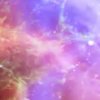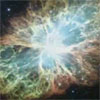CXC Home | Search | Help | Image Use Policy | Latest Images | Privacy | Accessibility | Glossary | Q&A
Tour of Crab Nebula
Quicktime MPEG
In 1054 A.D., a star's death in the constellation Taurus was observed on Earth. Now, almost a thousand years later, a superdense neutron star left behind by the explosion is spewing out a blizzard of extremely high-energy particles into the expanding debris field known as the Crab Nebula. This image combines data from Hubble, Spitzer and Chandra telescopes. The size of the X-ray image is smaller than the others because ultrahigh-energy X-ray emitting electrons radiate away their energy more quickly than the lower-energy electrons emitting optical and infrared light. By studying the Crab Nebula, astronomers hope to unlock the secrets of how similar objects across the universe are powered.
[Runtime: 0:43]
(Credit: X-ray: NASA/CXC/ASU/J.Hester et al.; Optical: NASA/ESA/ASU/J.Hester & A.Loll; Infrared: NASA/JPL-Caltech/Univ. Minn./R.Gehrz)
Quicktime MPEG
In 1054 A.D., a star's death in the constellation Taurus was observed on Earth. Now, almost a thousand years later, a superdense neutron star left behind by the explosion is spewing out a blizzard of extremely high-energy particles into the expanding debris field known as the Crab Nebula. This image combines data from Hubble, Spitzer and Chandra telescopes. The size of the X-ray image is smaller than the others because ultrahigh-energy X-ray emitting electrons radiate away their energy more quickly than the lower-energy electrons emitting optical and infrared light. By studying the Crab Nebula, astronomers hope to unlock the secrets of how similar objects across the universe are powered.
[Runtime: 0:43]
(Credit: X-ray: NASA/CXC/ASU/J.Hester et al.; Optical: NASA/ESA/ASU/J.Hester & A.Loll; Infrared: NASA/JPL-Caltech/Univ. Minn./R.Gehrz)
Animation and Composite Image of Crab Nebula
Quicktime MPEG
This sequence begins with an artist's animation of the explosion that produced the Crab Nebula, now an expanding debris field of extremely high-energy particles created from the death of a massive star. The view then fades into an image of the Crab composed of data from Chandra (light blue), Hubble (green and dark blue), and Spitzer (red).
[Runtime: 0:18]
(Animation: ESA/Hubble/M. Kornmesser & L. L. Christensen Image: X-ray: NASA/CXC/ASU/J.Hester et al.; Optical: NASA/ESA/ASU/J.Hester & A.Loll; Infrared: NASA/JPL-Caltech/Univ. Minn./R.Gehrz)
Quicktime MPEG
This sequence begins with an artist's animation of the explosion that produced the Crab Nebula, now an expanding debris field of extremely high-energy particles created from the death of a massive star. The view then fades into an image of the Crab composed of data from Chandra (light blue), Hubble (green and dark blue), and Spitzer (red).
[Runtime: 0:18]
(Animation: ESA/Hubble/M. Kornmesser & L. L. Christensen Image: X-ray: NASA/CXC/ASU/J.Hester et al.; Optical: NASA/ESA/ASU/J.Hester & A.Loll; Infrared: NASA/JPL-Caltech/Univ. Minn./R.Gehrz)
Return to Crab Nebula (24 Oct 06)




